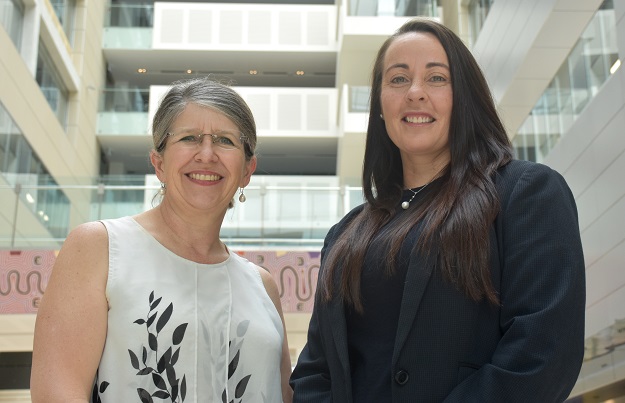
Gemma Van Halderen (left), Lead, ABS Population, Labour and Location Insights Division; and Alison Rose, Chief of Geoscience Australia’s Place, Space and Communities Division.
In our new Leaders Forum, we ask experts to look ahead into 2022. Today we speak with Alison Rose and Gemma Van Halderen.
Alison Rose is the Chief of Geoscience Australia’s (GA) Place, Space and Communities Division. Previously, she held senior executive positions within the private and public sectors. Gemma Van Halderen leads the Australian Bureau of Statistics’ (ABS) Population, Labour and Location Insights Division. A statistician, she has represented Australia at the UN Committee of Experts on Global Geospatial Information Management.
Which technologies will revolutionise the surveying, space or spatial sectors in 2022?
Alison Rose: I think AI will push new boundaries in the spatial and statistical sector. We are already seeing this with the use of digital twins. We are also seeing a step-change in the uptake of low-cost and accessible technologies based on precise positioning. Small satellites, unmanned aerial vehicles and advanced sensors are also having an impact. The IoT will accelerate the level of digital intelligence in the spatial sector. And, all of these new technologies will generate big data requiring multi-source/cross-domain data integration and analytics. We are also creating innovative ways to benefit from space, spatial and statistical data by making it findable, accessible, interoperable and reusable.
How is Australasia placed in the global context? Are we racing ahead or falling behind?
Gemma Van Halderen: Globally, Australia is well placed. Our willingness to innovate makes us recognised leaders in the adoption and application of new geospatial and statistical data technologies and in the development of new standards and methods. This is particularly apparent in the adoption of new positioning and Earth observation technology in agriculture and resources.
An exciting development is the Australian Government’s Digital Economy Strategy, which will place Australia as a leading digital economy by 2030. ABS and GA have a number of collaborative initiatives underway under this Strategy, most notably the Digital Atlas of Australia and the Australian Data Strategy. The Strategy will require industry input to be successful.
What’s on your wish list for 2022?
Alison Rose: Our wish is that industry, researchers and government come together on areas of common interest and invest in opportunities that integrate and enhance cooperation across the space and spatial and statistical sectors. Through collaboration, we’d like to see the linkages between upstream collection and downstream application drive our ability to respond to key challenges, such as the post-COVID-19 economic recovery and increased preparedness for natural disasters. For this to happen, it is imperative that we work together through the data supply chain, share data based on strong data quality standards and interoperability, and better connect spatial and non-spatial data into business systems.
Which challenges or opportunities should the industry be focused on?
Gemma Van Halderen: The 2020 bushfires and COVID-19 have driven the digital transformation of a wide range of services and provided a clear demonstration of the value of location-based, data-driven insights for decision making. We have an opportunity to capitalise on these changes and ensure geospatial and statistical capabilities are baked into recovery initiatives.
This will require data professionals to focus on collaborating with customers and across data communities, as well as clearly communicating the value we can deliver through geospatial information and technology. And we must look to develop well-rounded professionals with great communication and collaboration skills, alongside strong technical skills.
What are your organisations’ priorities for 2022?
Alison Rose/Gemma Van Halderen: In 2022, GA will be delivering on its Strategy 2028 through several programs such Positioning Australia, Digital Earth Australia and the initial release of the Digital Atlas of Australia, which will connect layers of data and enable users to visualise and analyse Australia’s large and complex geography like never before. The ABS will be delivering its ever-expanding suite of statistical products and services while reducing reporting burden on businesses and households. We will realise benefits from our Big Data, Timely Insights Program to use big data and digital sources for official statistics as well as lead and partner across the Australian Government to build the APS data profession, including expanding geospatial capabilities.
GA and ABS work in close partnership. An immediate priority is the Australian Climate Service, a collaboration between GA, ABS, CSIRO and BoM that aims to improve understanding of the threats posed by a changing climate and natural hazards, to limit the impacts now and in the future.
This article was first published in issue 116 of Position magazine.
Stay up to date by getting stories like this delivered to your inbox.
Sign up to receive our free weekly Spatial Source newsletter.












